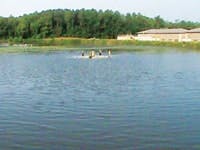The small town of Berryville, Va., with a population of 3,100, is situated 60 miles west of Washington, D.C., near the Shenandoah River, which flows into the Potomac River—one of the Chesapeake Bay’s major tributaries. Nutrient pollution from wastewater facilities has been an issue in the Chesapeake Bay region for some time as excess nitrogen or phosphorus in water encourages algae growth, which then depletes oxygen and causes fish and underwater plants to die.
In 2005, jurisdictions in the Chesapeake Bay region began implementing limitations on the amount of nutrients that wastewater plants could discharge. Berryville’s small wastewater treatment plant (WWTP), which has not undergone a substantial upgrade since the 1960s, needed an updated system to comply with these discharge requirements.
Out With the Old
According to David Tyrell, director of utilities for Berryville, the WWTP has been located on the same site since the 1930s, when it was originally installed with a trickling filter. Eventually, an aerated lagoon system was implemented in the 1960s—two lagoons run in series to provide biochemical oxygen demand and total suspended solids removal.
The lagoon system can treat 0.45 million gal per day (mgd). Disinfection currently is provided by two open-channel UV units that were installed in 2004 to replace the old Cl2 system. The effluent produced is pumped approximately four miles to the Shenandoah River for discharge.
The system won’t be in place for much longer, though. Berryville WWTP began its upgrade process in 2007 and is two years into the construction of its new facility, expected to be fully complete by October 2012.
After evaluating several processes and deciding what would help the town meet its nutrient-reduction requirements most effectively, Berryville settled on a membrane bioreactor system (MBR) to replace its aging infrastructure.
“With our area being highly agricultural and the fact that our facility was only given enough of a nutrient load to accommodate the current upgrade and not the predicted build out of the service area (estimated at 1.1 to 1.4 mgd), we decided to go with an MBR system,” Tyrell said.
With this process, the WWTP can provide a positive barrier for the reclaimed water to pass through and allow for the possible irrigation of farms along the discharge pipeline. This would give the utility the option to reduce its loadings in the future if it nears its nutrient limits.
The new facility’s design includes new headworks with coarse and fine screening, grit removal, biological system (four-stage Bardenpho process) and process building, a solids-handling facility, and effluent pipeline to the river to replace the 110-year-old line currently in use. New equipment also has been installed, including a 1,500- kW, 3,000-amp generator.
“It’s not often we get to see a V16 engine in such a small town,” Tyrell joked.
Berryville WWTP also decided to keep one of the lagoons as an emergency overflow, in case the new facility could not handle the load. “Many facilities dream of such a luxury. This effectively will give us a 6-million-gal storage tank,” Tyrell said.
Not All Smooth Sailing
The region’s geology caused challenges during the initial phases of the plant upgrade. The rock structure underground is full of voids and caverns and is thus prone to sinkholes. In order to avoid complications, compaction grouting had to take place before construction could begin. A 10-ft-by-10-ft grid was laid out under all new structures, and holes were drilled down into rock. Then, concrete grout was pumped into the holes under pressure to help stabilize the subsurface conditions. In total, just over 6,000 cu yards of grout were pumped into the ground to mitigate any problems.
According to Tyrell, when the plant upgrade is finished, Berryville WWTP will see a 90% reduction in levels of total nitrogen and total phosphorus, which will reduce the town’s yearly load by about 35,000 lb of nitrogen alone.
The improvements come with a large price tag, however. Funding for the project is coming from a $12.1-million grant from the Virginia Department of Environmental Quality, an $11.75 million, 0% interest, 25-year loan through the Virginia Revolving Loan Fund, and $4.5 million out-of-pocket for the town, which means higher sewer rates.
“The citizens of Berryville are to be commended for their understanding of the need to increase rates,” Tyrell said. “The Town Council has made difficult decisions to make this project possible and to fund it.”
Although the transition will take some work, Tyrell is optimistic. “This new facility is a big step for the town of Berryville. The operations staff looks forward to the challenges of learning the new system.”
Download: Here


